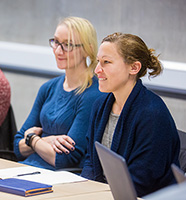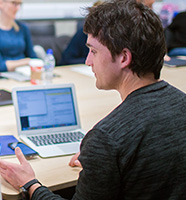About the project
About Being Lean and Seen
Context of the project
The advancement of project management (PM) knowledge and the development of PM capability of people is crucial to the successful delivery of projects. The awareness of the high impact of projects, and therefore also the influence of project management, to society and the economy has been increasing and became urgent to the EU countries in 2007 with the global recession. Interest in project management continues. Some recent figures illustrate this:
- It is assumed that the project-related expenditures in 2015 within the EU were around € 3.27 trillion, based on the share of the GDP
- The worldwide capital project and infrastructure market forecasts suggest that this market will be worth over € 7.9 trillion per year by 2025 – up from € 3.5 trillion in 2012
- Furthermore it is believed that 6% of projects are “wholly unsuccessful” and that less than a quarter (22%) of all projects undertaken wholly meet their objectives
- This leads to about € 0.2 trillion currently wasted on wholly unsuccessful projects within the EU and an unknown amount of money wasted on only partially successful projects
These exemplary figures show that any improvement in the management of projects can have a significant positive financial impact for the overall EU economy and society. This is particularly applicable considering that a lot of projects are tax payer funded and therefore accountable for the appropriate use of the money. The airport Berlin Brandenburg BER in Germany is just one prominent large scale example of this, where the cost almost doubled from € 2.83 billion to at least € 4.3 billion in 2012 with no end in sight and no reliable cost forecast available. Yet, to our knowledge there has been no major research project funded by the EU/EC in the area of PM.
Need for improved project management
All the issues highlighted above show that there is a huge need and potential impact in improving PM to meet the challenges of the 21st century for countries both inside and outside the EU. From the point of view of EU countries there are two key broad issues:
- the challenge of successfully delivering internally and tax payer-funded projects within the EU or their own country borders
- the challenge of contributing to the successful delivering of projects in countries outside the EU, where EU-member PM capability and expertise is being exported through the winning of overseas contracts
In terms of the second issue, the value of the future global projects market is huge. As mentioned above the capital project and infrastructure market will be worth in excess of €7 trillion per year by 2025. Given that the majority of the growth is expected to come from emerging economies emphasises the importance of developing EU PM capability and expertise to stay competitive in operating effectively in this global market against other country competitors.
These statistics do not include all the other types of projects that are carried out with various industries from pharmaceuticals to software to organisational change. So, in terms of the first issue, a survey in 2001 showed that US public and private sectors combined spent some € 2.1 trillion on internal projects every year. There are no comparable numbers available for the EU, but if it is assumed that the share of GDP is about the same for the EU, project-related expenditures in 2015 would have been around € 3.27 trillion. A substantial sum of money that shows the importance of projects within the EU countries’ own borders.
Alongside the directly related factors of successful and unsuccessful PM are the work-related psycho-social risks and in this respect a recent EU report stated that “the cost related to stress and psychosocial risks at work paid by societies and organisations is considerable”.
In financial terms this is also a substantial cost to society and the economy, e.g. in 2002, the European Commission calculated the costs of work-related stress, which is just one component of psycho-social risk, in the EU-15 at €20 billion a year.
By addressing psycho-social issues in projects, where those involved in PM will be at risk of high levels of stress, as well as other psycho-social threats, the programme will have a significant positive impact in terms of mitigating for these risks.
3.27
trillion
euros spent on project-related expenditures in the EU in 2015
6%
of projects are deemed as 'wholly unsuccessful'
7.9
trillion
euros forecasted as the worth of worldwide capital projects and infrastructure market by 2025
Research areas
From a wider perspective of advancing knowledge in project management, the programme enriches and extends the field beyond its current intellectual foundations and connects it more closely to the challenges of contemporary practices. The multidisciplinary perspective of the planned work goes beyond the traditional boundaries of the PM body of knowledge to develop a holistic framework which will enable the successful delivery of projects both now and in the future. It is based on three major pillars:
- “Being Lean” – adapt, enhance and advance management practices from other industries in response to the need for efficiency and effectiveness of projects
- “Begin Seen” – incorporate the perspective of the people responsible for delivering projects by accentuating the psycho-social aspects
- “Being Lean and Seen” – adapt projects to dynamic environments in order to sustain competitive advantage in the long run with Dynamic Capabilities and adapt PM methods to developing countries
Identify challenges
The PM role has to cope with a diverse range of project stakeholders, with often complex and competing requirements. As the diversity of these stakeholders increase and their requirements change there are new major challenges emerging all the time that PM has to address. There is a need to investigate what the challenges are, so that PM as a discipline can be proactive in developing systems to meet them; and such an investigation is an important part of this proposed exchange programme.
Being Lean
Furthermore, to meet the measures of success that these stakeholders use means that projects have to be delivered both efficiently and effectively. In response to the need for efficiency and effectiveness to projects PM has looked to adapt management practices from other industries, such as lean manufacturing/production management, which has its origins in the automotive industry. In this proposal we refer to this phenomena as “being Lean”. The PM body of knowledge, in relation to the success of adaptions of being lean to projects, is still immature and it is very much an emerging field. Possible structural and cultural barriers, as yet unexplored, have also been identified to being lean and moves are being made to integrate lean with other PM approaches, such as agile PM. Also a new strand of research is seeking to understand what it means to increase maturity in Lean PM, to maximise its potential to increase organisational performance and capability, though this research is still very much in its infancy. So an important pillar of the proposed exchange programme is to advance knowledge and to undertake research in relation to these different aspects of being lean in project environments, which will draw from the disciplines of PM, psychology, management sciences, production/manufacturing, engineering management, computer sciences, innovation management, change management and organisational behaviour/development.
Being Seen
Being lean is desirable as it can result in a highly efficient management process that minimises waste and maximises value to the customer. Yet there are critics of the lean approach to projects that highlight its failure to consider the impact of being lean on the project team members that have to implement it, for example the high levels of psychological pressure and stress that can be put on people in such environments, and the adverse impact it can have on the relationships between the parties to the project. This highlights the second important pillar of the proposed exchange programme i.e. psycho-social aspects of PM and the social relationships between people. In this proposal we refer to these considerations as “being seen”, in the sense that a complete picture of an efficient and effective PM system has to incorporate the perspective of the people responsible for delivering projects i.e. the PM system needs to be seen to treat people in a fair way and to not put them under undue stress.
All these different social relationships can be very difficult for PM to manage. The exchange programme will enable research and knowledge sharing, novel in the context of projects, which utilises concepts, such as organisational justice and organisational justice climate, from the general management/organisational behaviour and development literature, coping strategies theory, from organisational psychology, to build the psycho-social pillar of “being seen”.

"Understanding the relationship between people's behaviours and capabilities is an important factor in managing successful projects and developing the PM profession."
Being Lean and Seen
The final focus of the exchange programme, which relates to both pillars of being Lean and being Seen is the role of PM in achieving innovation and change. In order to adapt to dynamic environments and sustain competitive advantage in the long run companies need Dynamic Capabilities (DC). A specific DC is that of “ambidexterity”. Which is the capability of an organization to exploit its current knowledge and competencies and to simultaneously explore new ones. To become effective and efficient at being Lean and being Seen will require companies to demonstrate such ambidexterity; as it will involve exploiting existing PM processes and exploring new ones. This will require the management of innovation, in terms of new processes and managing change, to embed these new processes. The management literature assumes that there is a conflict between exploitation and exploration activities, thus business units with focus on exploitation are often separated from those with focus on exploration. Project teams can link exploration and exploitation activities within organizations and thus enable ambidexterity i.e.
- Companies often use projects to enhance organisational learning processes. They do this for radical as well as for incremental innovation
- People who work in project teams often interact with business units with a focus on exploitation or exploration. Thus, they transfer knowledge and hold the role of gatekeepers at the boundaries between different departments or organisations
What is not clear though is a thorough understanding of the specific ways in which project teams mediate between exploration and exploitation activities, as well as the details of the PM roles undertaken by the various actors working in such teams. In relation to this second area, the PM roles, the notion of PM as a Dynamic Collaborative Social Practice is a potentially fruitful avenue for investigation, as being ambidextrous moves beyond notions of control, to embrace not only flexibility and agility but also to account for the inherent complexity of projects as a contingent independent variable that impacts on many subsequent decisions that influence PM practice. In this case, practices associated with being Lean and being Seen. Therefore, the exchange programme will enable research and knowledge sharing in relation to the topics of innovation and change, as a fundamental piece of the jigsaw in developing a PM framework to be Lean and Seen.
Developing a holistic framework
Thus the overall aim of this exchange programme is to bring together an international and multi-disciplinary team of researchers with a wide variety of skills in research relating to being Lean and being Seen in projects. Undertaking the programme will help industry tackle the major challenges they face in delivering projects successfully in the 21st century, both today and in the future; challenges that require specialist knowledge, innovative, cost-effective and sustainable solutions and that will benefit from a collaborative and multi-disciplinary approach. The proposed research covers fundamentals of PM as well as their application in different country contexts i.e. developed and developing countries and in different industry contexts, such as infrastructure, construction, engineering and IT. The programme comprises of a RISE project involving 10 partners (nine from MS and one from the TC of Malaysia), with extensive exchange of researchers over a period of 48 months, in order to fully explore the complementary strengths and synergies within the consortium.





